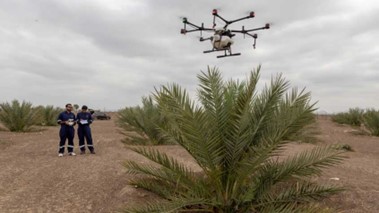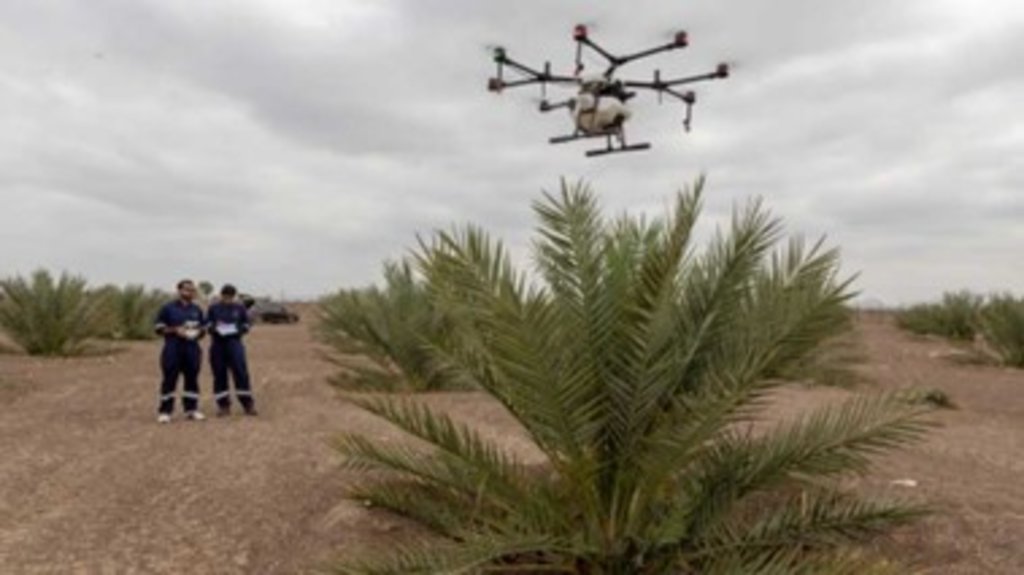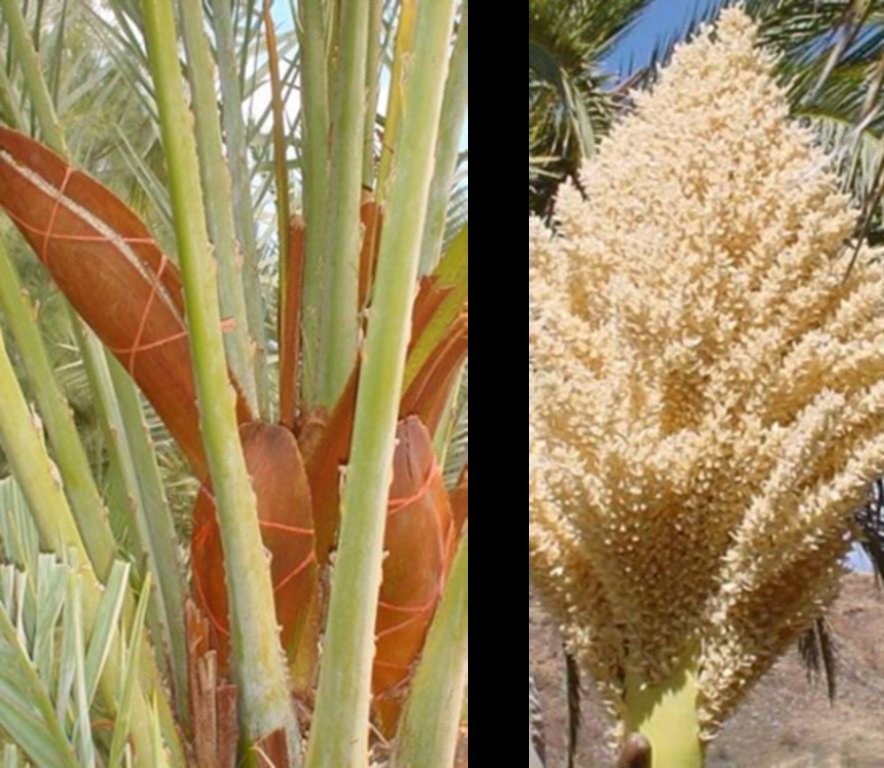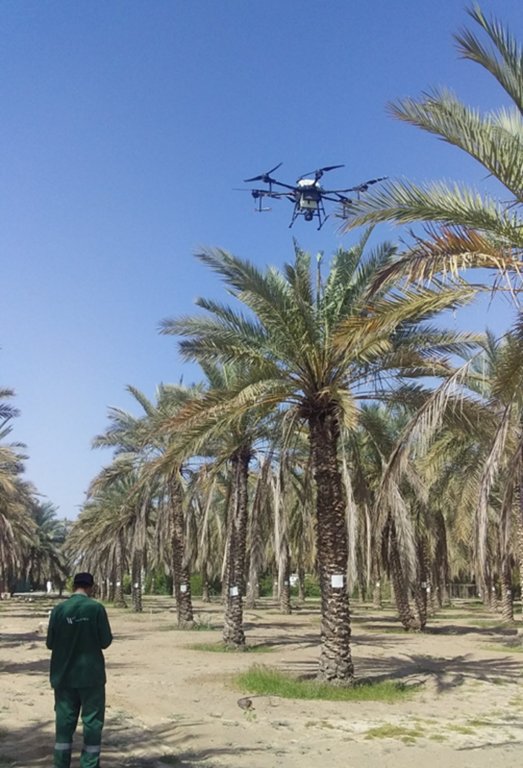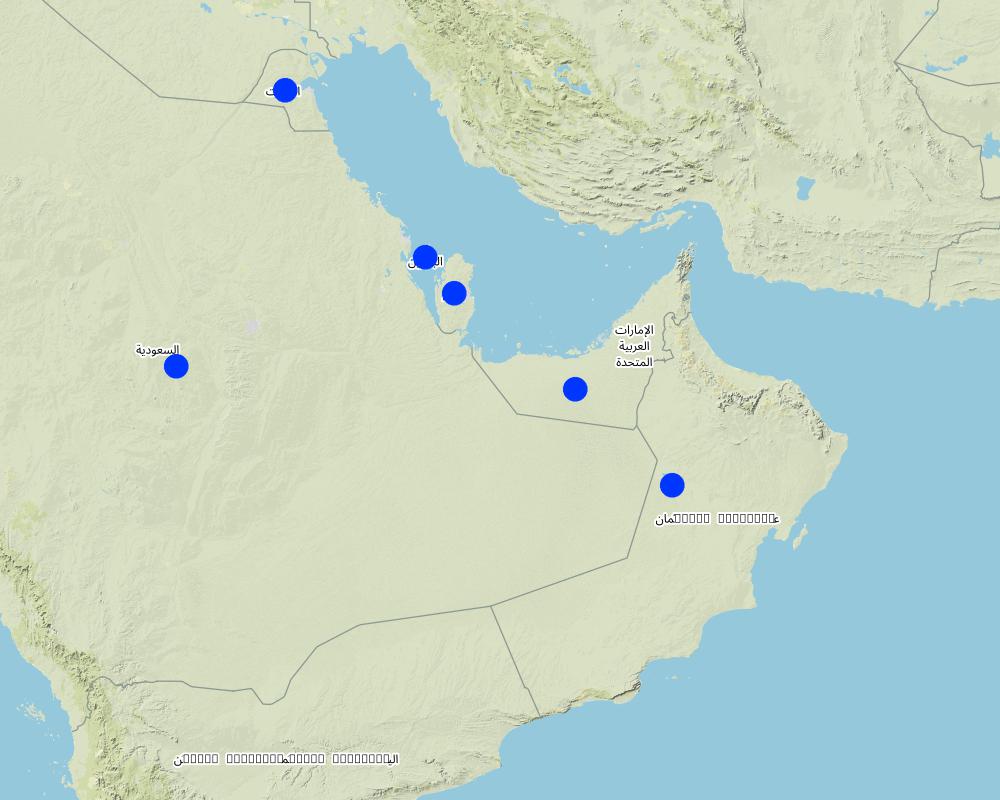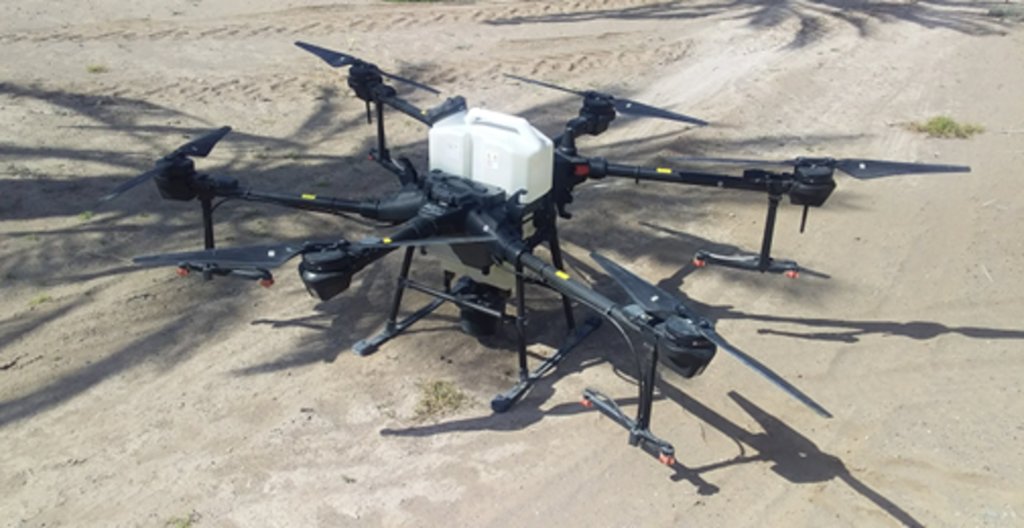Liquid Pollination for Date Palm Production [Oman]
- Creation:
- Update:
- Compiler: Joren Verbist
- Editor: –
- Reviewers: William Critchley, Rima Mekdaschi Studer
technologies_5917 - Oman
View sections
Expand all Collapse all1. General information
1.2 Contact details of resource persons and institutions involved in the assessment and documentation of the Technology
Key resource person(s)
Regional Coordinator APRP:
Niane Abdoul Aziz
International Center of Agriculture Research in the Dry Areas (ICARDA)
Lebanon
Senior Natural Resources Economist:
Dhebibi Boubaker
International Center of Agriculture Research in the Dry Areas (ICARDA)
Lebanon
Date Palm Consultant:
Abdulbasit Ibrahim Oudah
International Center of Agriculture Research in the Dry Areas (ICARDA)
Lebanon
Consultant - Date Palm Specialist (GCC):
Abdallah Ben Abdallah
International Center of Agriculture Research in the Dry Areas (ICARDA)
Oman
Directorate General of Agriculture & Animal Research.
Al-Shaili Khalid
Agriculture & Animal Research
Oman
Name of project which facilitated the documentation/ evaluation of the Technology (if relevant)
ICARDA Institutional Knowledge Management InitiativeName of the institution(s) which facilitated the documentation/ evaluation of the Technology (if relevant)
International Center for Agricultural Research in the Dry Areas (ICARDA) - Lebanon1.3 Conditions regarding the use of data documented through WOCAT
The compiler and key resource person(s) accept the conditions regarding the use of data documented through WOCAT:
Ja
1.4 Declaration on sustainability of the described Technology
Is the Technology described here problematic with regard to land degradation, so that it cannot be declared a sustainable land management technology?
Nee
2. Description of the SLM Technology
2.1 Short description of the Technology
Definition of the Technology:
Pollination of date palms is essential to ensure good quality yield. Currently, pollination is done manually: this is a costly process and dangerous. Mechanised Liquid Pollination (MLP) reduces variable costs by 80% and prevents causalities while maintaining yield.
2.2 Detailed description of the Technology
Description:
In the Middle East, the date palm is a common crop with significant cultural and economic value. Date palms are typically found in dry, arid and hot areas. Due to climate change in the form of high temperatures, heatwaves, increased water scarcity, harsh winds, poor pollination and the increase of pests, production problems are increasing. The International Center of Agricultural Research in Dry Areas (ICARDA) acknowledged these challenges and led an initiative to address the key issues. One major challenge identified was the labour-intensive and dangerous practice of manual date palm pollination: a farmer climbs up the tree and spreads the pollen. This is expensive and dangerous. An alternative tested was mechanised liquid pollination. Pollen is mixed with water and then sprayed onto the inflorescence of the palm tree. The costs are reduced substantially, and there is a three times higher benefit-cost return. In addition, pollination is now less depending on the climate, thus more resilient to climate change.
Prior to pollinating, the male spathes are cut off to avoid the losses of pollen. This is done when the spathes begin to ripen. The spathe is brought to a temperature-controlled room to dry for few days. Then the inflorescence is opened and strands are left to dry further. As the moisture content of the inflorescence decreases, its flowers begin to open and the pollen is released. It is captured, and mixed with water. Pollination is then carried out mechanically with a pump system or drones.
Regarding the costs, based on 140 date palms per hectare this corresponds to 28 inflorescences required. These are processed into 560 grams of pollen following the methodology as described above. The cost per inflorescence is around 6 Omani Riyal (1 Omani Riyal = 2.6 USD). The actual pollination through a drone, also known as showering, costs around 150 Omani Riyal. Showering is done four times, with each consisting of an operation time of 3 hours, so 12 hours in total. In other words, the total cost per hectare for applying this liquid pollination through showering is estimated at around 518 Omani Riyal, or 1,350 USD. The purchase costs of a drone and the related devices is estimated at 8000 Omani Riyal.
To conclude, this innovation is very useful because it substantially lowers variable costs of date palm production and prevents the risks of accidents under the conventional method of pollination. However, the required investments are very large for individual farmers.
2.3 Photos of the Technology
2.5 Country/ region/ locations where the Technology has been applied and which are covered by this assessment
Country:
Oman
Region/ State/ Province:
Kingdom of Saudi-Arabia; Qatar; Kuwait; Bahrain; United Arabic Emirates
Specify the spread of the Technology:
- applied at specific points/ concentrated on a small area
Is/are the technology site(s) located in a permanently protected area?
Nee
Map
×2.6 Date of implementation
Indicate year of implementation:
2011
2.7 Introduction of the Technology
Specify how the Technology was introduced:
- during experiments/ research
- through projects/ external interventions
3. Classification of the SLM Technology
3.1 Main purpose(s) of the Technology
- reduce risk of disasters
- adapt to climate change/ extremes and its impacts
- create beneficial economic impact
3.2 Current land use type(s) where the Technology is applied
Land use mixed within the same land unit:
Nee

Cropland
- Tree and shrub cropping
Tree and shrub cropping - Specify crops:
- dates
Is intercropping practiced?
Nee
Is crop rotation practiced?
Nee
3.3 Has land use changed due to the implementation of the Technology?
Has land use changed due to the implementation of the Technology?
- No (Continue with question 3.4)
3.4 Water supply
Water supply for the land on which the Technology is applied:
- mixed rainfed-irrigated
3.5 SLM group to which the Technology belongs
- forest plantation management
- Improved Pollination
3.6 SLM measures comprising the Technology

agronomic measures
- A7: Others

management measures
- M2: Change of management/ intensity level

other measures
Specify:
Liquid Pollination
3.7 Main types of land degradation addressed by the Technology

soil erosion by water
- Wt: loss of topsoil/ surface erosion

biological degradation
- Bq: quantity/ biomass decline
3.8 Prevention, reduction, or restoration of land degradation
Specify the goal of the Technology with regard to land degradation:
- adapt to land degradation
4. Technical specifications, implementation activities, inputs, and costs
4.1 Technical drawing of the Technology
Technical specifications (related to technical drawing):
Drone equipment used for showering. Drone may vary; this drone has a length of around 1 meter and a width of around 0.74 meter.
4.2 General information regarding the calculation of inputs and costs
Specify how costs and inputs were calculated:
- per Technology area
Indicate size and area unit:
1 hectare
other/ national currency (specify):
Omani Riyal
If relevant, indicate exchange rate from USD to local currency (e.g. 1 USD = 79.9 Brazilian Real): 1 USD =:
0.39
Indicate average wage cost of hired labour per day:
10
4.4 Costs and inputs needed for establishment
| Specify input | Unit | Quantity | Costs per Unit | Total costs per input | % of costs borne by land users | |
|---|---|---|---|---|---|---|
| Equipment | Drone package (including sprayer, tank, controls, etc) | 1.0 | 8000.0 | 8000.0 | ||
| Total costs for establishment of the Technology | 8000.0 | |||||
| Total costs for establishment of the Technology in USD | 20512.82 | |||||
Comments:
The purchase costs of a drone and the related devices is estimated at 8000 Omani Riyal.
4.5 Maintenance/ recurrent activities
| Activity | Timing/ frequency | |
|---|---|---|
| 1. | Cut off male spathes | February-March |
| 2. | Drying of spathes (two times, three days) | Until inflorescence open up |
| 3. | Cut off inflorescence (three times) | February-March |
| 4. | Extract pollen from inflorescence | |
| 5. | Liquid Pollination | February-March |
Comments:
Firstly, to cut off the male spathes, to avoid losses of pollen. This is when the spathe begin to ripe, usually in February-March .Secondly, the spathe is brought to a temperature controlled room (18-22 degrees Celsius) to dry for some days. Thirdly, after these days, the inflorescence is cut from the spathe, and left to dry further. The inflorescence should be dried in dark place to maintain viability. Fourthly, as the moisture content of the inflorescence decreases, its flowers begin to open and the pollen are released. Therefore, pollen can now be extracted from the inflorescence. This can be done manually or mechanically. Finally, the pollen are mixed with water in a ratio of four grams pollen to one liter water, suitable for pollination roughly 50 date palms. Pollination is done in March-April, and is done mechanically with a pump system.
4.6 Costs and inputs needed for maintenance/ recurrent activities (per year)
If you are unable to break down the costs in the table above, give an estimation of the total costs of maintaining the Technology:
518.0
Comments:
Regarding cost estimations: there are typically 140 date palms per hectare. This relates to 28 required inflorescences that are processed into 560 grams of pollen following the advice as described above. The cost per inflorescence is around 6 Omani Riyal. 1 Omani Riyal is 2.6 USD. The actual pollination through a drone, also known as showering, costs around 150 Omani Riyal. Showering is done four times each consisting of an operation time of 3 hours, so 12 hours in total. In other words, the total cost per hectare for applying this liquid pollination through showering is estimated at around 518 Omani Riyal, or 1,350 USD.
5. Natural and human environment
5.1 Climate
Annual rainfall
- < 250 mm
- 251-500 mm
- 501-750 mm
- 751-1,000 mm
- 1,001-1,500 mm
- 1,501-2,000 mm
- 2,001-3,000 mm
- 3,001-4,000 mm
- > 4,000 mm
Agro-climatic zone
- arid
5.2 Topography
Slopes on average:
- flat (0-2%)
- gentle (3-5%)
- moderate (6-10%)
- rolling (11-15%)
- hilly (16-30%)
- steep (31-60%)
- very steep (>60%)
Landforms:
- plateau/plains
- ridges
- mountain slopes
- hill slopes
- footslopes
- valley floors
Altitudinal zone:
- 0-100 m a.s.l.
- 101-500 m a.s.l.
- 501-1,000 m a.s.l.
- 1,001-1,500 m a.s.l.
- 1,501-2,000 m a.s.l.
- 2,001-2,500 m a.s.l.
- 2,501-3,000 m a.s.l.
- 3,001-4,000 m a.s.l.
- > 4,000 m a.s.l.
Indicate if the Technology is specifically applied in:
- not relevant
5.3 Soils
Soil depth on average:
- very shallow (0-20 cm)
- shallow (21-50 cm)
- moderately deep (51-80 cm)
- deep (81-120 cm)
- very deep (> 120 cm)
Soil texture (topsoil):
- coarse/ light (sandy)
Soil texture (> 20 cm below surface):
- coarse/ light (sandy)
Topsoil organic matter:
- low (<1%)
5.4 Water availability and quality
Ground water table:
5-50 m
Availability of surface water:
medium
Water quality (untreated):
for agricultural use only (irrigation)
Water quality refers to:
both ground and surface water
Is water salinity a problem?
Ja
Is flooding of the area occurring?
Nee
5.5 Biodiversity
Species diversity:
- low
Habitat diversity:
- low
5.6 Characteristics of land users applying the Technology
Sedentary or nomadic:
- Sedentary
Market orientation of production system:
- mixed (subsistence/ commercial)
Off-farm income:
- 10-50% of all income
Relative level of wealth:
- average
Individuals or groups:
- individual/ household
Level of mechanization:
- manual work
- mechanized/ motorized
Gender:
- men
Age of land users:
- middle-aged
5.7 Average area of land used by land users applying the Technology
- < 0.5 ha
- 0.5-1 ha
- 1-2 ha
- 2-5 ha
- 5-15 ha
- 15-50 ha
- 50-100 ha
- 100-500 ha
- 500-1,000 ha
- 1,000-10,000 ha
- > 10,000 ha
Is this considered small-, medium- or large-scale (referring to local context)?
- medium-scale
5.8 Land ownership, land use rights, and water use rights
Land ownership:
- state
- individual, titled
Land use rights:
- communal (organized)
- individual
Water use rights:
- communal (organized)
Are land use rights based on a traditional legal system?
Ja
5.9 Access to services and infrastructure
health:
- poor
- moderate
- good
education:
- poor
- moderate
- good
technical assistance:
- poor
- moderate
- good
employment (e.g. off-farm):
- poor
- moderate
- good
markets:
- poor
- moderate
- good
energy:
- poor
- moderate
- good
roads and transport:
- poor
- moderate
- good
drinking water and sanitation:
- poor
- moderate
- good
financial services:
- poor
- moderate
- good
6. Impacts and concluding statements
6.1 On-site impacts the Technology has shown
Socio-economic impacts
Production
crop production
Comments/ specify:
Liquid Pollination does not result necessarily in increased production.
crop quality
Comments/ specify:
Pollination is enhanced, improving the quality.
risk of production failure
Comments/ specify:
Liquid pollination decreased dependency on natural pollination which can fail due to changing climate.
land management
Comments/ specify:
Less failure of falling down the tree and less labour consuming with respect to conventional pollination.
Income and costs
farm income
Comments/ specify:
Less costs for labour, resulting in more net-income.
workload
Comments/ specify:
Less labour required with respect to conventional pollination.
Socio-cultural impacts
situation of socially and economically disadvantaged groups
6.3 Exposure and sensitivity of the Technology to gradual climate change and climate-related extremes/ disasters (as perceived by land users)
Gradual climate change
Gradual climate change
| Season | increase or decrease | How does the Technology cope with it? | |
|---|---|---|---|
| other gradual climate change | Worsened pollination | increase | very well |
6.4 Cost-benefit analysis
How do the benefits compare with the establishment costs (from land users’ perspective)?
Short-term returns:
slightly negative
Long-term returns:
very positive
How do the benefits compare with the maintenance/ recurrent costs (from land users' perspective)?
Short-term returns:
very positive
Long-term returns:
very positive
Comments:
Return of investment in the short term is slightly negative due to high investment costs.
6.5 Adoption of the Technology
- 1-10%
Of all those who have adopted the Technology, how many did so spontaneously, i.e. without receiving any material incentives/ payments?
- 0-10%
6.6 Adaptation
Has the Technology been modified recently to adapt to changing conditions?
Nee
6.7 Strengths/ advantages/ opportunities of the Technology
| Strengths/ advantages/ opportunities in the land user’s view |
|---|
| Saves time and effort (reducing labor cost and improving the effectiveness and productivity of the labor used) |
| Reduces the quantity of pollen needed |
| Reduces labor and pollen costs |
| Reduces the risk of climbing accidents to laborers |
| Strengths/ advantages/ opportunities in the compiler’s or other key resource person’s view |
|---|
| Reduces the risk low fruit set by pollinating during the peak period of flowering. |
| Improves the quality of the fruits and consequently the profitability of the varieties intended for export. |
| Improves the fruit setting percentage. |
| Contributes to reducing harvesting losses. |
6.8 Weaknesses/ disadvantages/ risks of the Technology and ways of overcoming them
| Weaknesses/ disadvantages/ risks in the land user’s view | How can they be overcome? |
|---|---|
| High initial costs | Improve the production of these devices (drones and extraction device). |
| Limited number of date palm trees per farmer (the investment in the pollination extraction device is not profitable). | Creation of cooperatives so that the investment can be shared. |
| No interest from the younger generation in date palm production. | Increase economic potential |
| Weaknesses/ disadvantages/ risks in the compiler’s or other key resource person’s view | How can they be overcome? |
|---|---|
| Resistance of farmers to adopting the new technology and to changing their practices (farmers are accustomed to the old technology of hand pollination). | Good dissemination practices to show the succes e.g. by farmers field days. |
| Lack of specialized extension staff for the date palm. |
7. References and links
7.1 Methods/ sources of information
- interviews with SLM specialists/ experts
- compilation from reports and other existing documentation
When were the data compiled (in the field)?
2021
Links and modules
Expand all Collapse allLinks
No links
Modules
No modules


